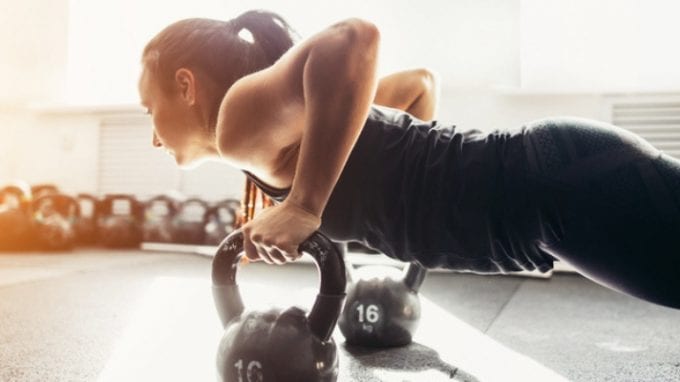When trying to conceive, exercise can help to improve your fertility and chance for success. In addition to the fertility benefits that exercise can play, having a great workout regime in place prior to pregnancy will also help to promote a healthier pregnancy, delivery, postpartum, and give your baby a healthy start.
If you are new to regular exercising, it’s worth noting that building a routine will also help to improve your overall health. The natural effects of lowering glucose levels and blood pressure, and managing your weight are all simple side effects of a healthy fitness routine.
If you are a fitness enthusiast, it is important to make sure you are rediscovering your limits to ensure you are not over doing it. Try to avoid the “no pain, no gain” mindset. Intense calorie-burning activities that require your body to burn more calories than you consume in a day, can impact your fertility. As a result, your body may perceive this extensive activity level as stress and may not encourage healthy or regular ovulation.
To help you on your journey to better fitness, we have put together a month-long guide to ease your way into a routine and help get you started on your journey to improved fertility health and ultimately to a healthy pregnancy.
A great way to begin your fitness journey is to create a weekly schedule. Pick the days that will work best for you to work out and try to keep it the same throughout the month. This will help you to develop a routine and prepare for what is coming next! Training three days a week is an ideal routine and a great place to begin. Once you’ve gotten into the exercise habit, including an additional day for yoga and walking in between your scheduled workouts can help balance your fitness approach and provide your body with enough physical activity to maintain consistent movement. Start your first week in a practical mindset, begin with three to four days of activity and build up to five days of physical activity.
Example Beginning Weekly Workout Schedule:
| Mon. | Tues. | Wed. | Thurs. | Fri. | Sat. | Sun. |
| Upper Body – Pilates | Walk – 30 min
|
Rest Day | Lower Body – Pilates | Rest Day | Walk – 30 min | Rest Day |
Example Weekly Workout Schedule:
| Mon. | Tues. | Wed. | Thurs. | Fri. | Sat. | Sun. |
| Upper Body – Pilates | Walk – 30 min
Core – Pilates |
Rest Day | Lower Body – Pilates | Yoga | Rest Day | Cycling |
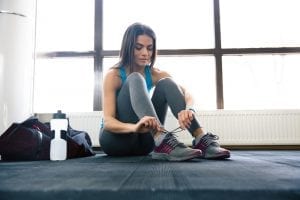
Be sure to mix your routine up to fit the kind of workouts you enjoy the most to ensure you’ll be enticed to maintain your new routine. Try to do light cardio such as running, swimming, cycling, or walking, two to four times per week and include strength training with weights or bodyweight two times a week. Do not forget to stretch daily! This will help to avoid injuries and help your body heal between workouts.
Sample Daily Workout:
Upper Body Workout
- Intensity: Moderate – Time: 30 minutes
Perform eight to ten reps of each exercise for a total of two to four sets.
- Shoulder Raise: On a mat, rest on your knees, heels supporting your glutes, holding a weight (or water bottle) in each hand. Raise your arms out slightly behind the body, keeping them straight and pulsing your hands in towards your midsection, behind the back for 45 seconds. For this exercise, one rep of 45 second intervals is considered one set.
- Chest Press: Feet hip-width apart and arm distance from a solid and sturdy wall, perform a vertical push-up against the wall, or while laying on your back on the floor or on a fitness bench, perform a light-weighted dumbbell chest press.
- Bicep Curls: Standing hip-width apart, hold a light weight or water bottle and slowly lift the weight from your side to your chest, bending only at the elbow. If desired, increase intensity by adding balancing to this by standing on one leg perform a single bicep curl with the alternate arm.
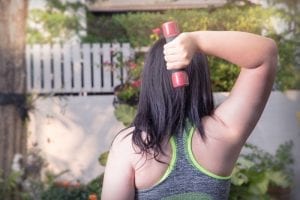
- Pilates Press: Start in a traditional, full push-up position. Balance on your hands and toes (if you are new to this or need the extra support, you can keep both knees on the floor instead in a modified push up position.) Bend your right knee 90 degrees so that your toes point up. Slowly, bend your elbows directly behind you, keeping your arms close to your body and lower yourself down into a push up a few inches towards the floor and then press back up. After eight to ten reps switch legs and repeat.
Stretch
- Overhead side stretch: Standing tall, raise your right arm up overhead and lean your torso toward the left to stretch the side body. Return to center and repeat with the left arm raised, leaning your torso to the right to stretch the other side. Continue to switch off stretching to each side and holding each side stretch for 45 seconds.
Rest Day Tips
An essential part of creating a fitness routine is to not forget that your body needs rest. This is especially the case if you are starting a brand-new fitness journey! Try and schedule your rest day out every two to three days. This will help to break up your week and provide you down time to recover.
Things to Remember
Try to mix your workouts up to allow for variety. This way if it is raining outside and you can’t take your daily walk, you can still go catch a Zumba or cycling class at the gym or enjoy some Pilates in your living room. By mixing it up, you will have different options that you are used to and will be more motivated to keep going.
If your workout choices were not your favorite last week, then take the chance to mix things up! Maybe you didn’t enjoy that cycling class at the gym, why not replace it with a fun round of Zumba dancing! Or perhaps you realized that Pilates is not for you and you’d prefer a brisk walk around the neighborhood. This is your fitness routine, so if you do not enjoy what you are doing, change things up!
Sample Workout:
Leg Day Workout
- Intensity: Moderate – Time: 30 minutes
Perform eight to ten reps of each exercise for a total of two to four sets.
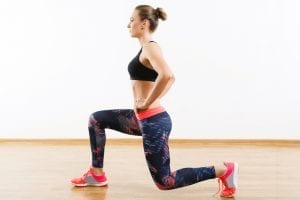
- Wall Squats – Start standing up against a wall with a Pilates ball in the center of your back. Feet should be about a foot away from the wall. Slowly roll down on the ball to come into a squat position by pushing your knees to the side while moving hips back. Make sure that your hips are not lower than your knees. Roll back up keeping your knees out and chest up.
- Bridge Pose: Start laying on your back with knees bent and feet flat on the floor, hip-width distance apart. Use your abdominals to lift your pelvis off the ground, forming a diagonal line from shoulders to knees. Hold until you feel the hamstrings and glutes start to warm up. For an extra challenge hold a ball between your legs.
- Bridge Pose – Toe Taps: Start laying on your back with knees bent and feet flat on the floor, hip-width distance apart. Lift your pelvis up to bridge position then lift one leg into table top position. Keep your top knee bent and maintain the bridge position, lower and lift the leg to tap the toe down towards the floor, then lift it back to table top. Keep both hips level, and your hip-bones pointing toward the sky.
- Side Lying Kick: Start laying on your side, support your head with a bent arm, legs extended slightly forward, and bent at a small diagonal. Lift and straighten your top leg, bring it in line with your spine and lift to hip height. Bring your leg forward 45 degrees, flexing toes. Bring your leg back in line with your spine, while pointing your toes.
Stretches :
- Standing Hamstring Stretch – Stand tall with your feet hip-width apart, knees slightly bent, arms by your sides. Exhale as you bend forward at the hips, lowering your head toward floor, while keeping your head, neck and shoulders relaxed. Wrap your arms around the backs of your legs and hold anywhere from 45 seconds to two minutes. Bend your knees and roll up when you’re done.
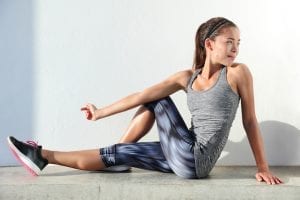
Rest Day Tips
Why not try to have an active rest day this week! An active rest day is a great way to give your body rest without being fully sedentary. Try to add in another round of calming yoga, hiking, or a calm and steady walk. Active rest days are a great way to rest your muscles, while doing something fun that keeps your body in motion.
Things to Remember
If you enjoy running, it can be a great workout. However, try not to overdo it if your body is not used to running, as it could be a cause for concern with your fertility. If running isn’t in the cards for you, don’t worry, a light jog or even a brisk walk can provide you with the same benefits and without the possible risks.
During the second week of your new fitness routine, you may find that your muscles are awfully sore. Don’t forget that stretching after each workout will help to provide your body with the relief that it needs, even if it is just for five to ten minutes a day. Another great thing to try is a snack of pineapple or tart cherries as these contain Bromelain, which offers great anti-inflammatory benefits that are also helpful for your fertility.
You are halfway through your first month of your new fitness plan! Give yourself a pat on the back!
This week, if you haven’t added it into your routine yet, don’t forget your core. You will want to try to develop your abdominal muscles before you do get pregnant. During pregnancy your belly grows, your breasts get bigger, and your center of gravity shifts. This can cause a strain on other parts of your body. Strengthening your abdominal and back muscles will help to give you better balance and posture. This will hopefully help you avoid back pain during pregnancy.
Sample Workout
Core Workout
Perform eight to ten reps of each exercise for a total of two to four sets. You will want to have a yoga mat or soft surface to lay on.
- Leg Circle – Lie face up with your arms by your sides, palms down. Bend your left knee and place your left foot flat on the floor. Extend your right leg up so that it’s perpendicular to the floor. Circle your right leg out to the side, down toward the ground, and return to your starting position. Make the circle as big as you can while still keeping your lower back on the floor. Reverse the circle. Complete all reps one on leg, and then repeat on the other.

- Scissor Kick – Lie face up. Extend your right leg up so that it’s perpendicular to the floor. Bring your hands behind your right leg, pulling it in toward your face, and curl your head up. Lift your left leg off the floor a few inches. Switch legs, pulling your left leg in toward you and letting your right leg hover above the floor. Continue switching your legs.
- Pendulum – Lie face up with your arms extended out to your sides. Bend your knees over your hips and lift your feet off the mat. Let both knees fall to the right, keeping your lower back on the floor. Return to starting position, and then repeat on the other side.
- Plank Leg Lift – Plant hands directly under shoulders (slightly wider than shoulder width) like you’re about to do a push-up. Ground toes into the floor and squeeze glutes to stabilize your body. Neutralize your neck and spine by looking at a spot on the floor about a foot beyond your hands. Your head should be in line with your back. Alternate lifting one leg off the floor as high as you can but not past shoulder height. Keep your core, butt, and quads engaged to avoid rocking your hips.
- Slow Motion Mountain Climber – Start in a traditional plank — shoulders over hands and weight on just your toes. With your core engaged, bring your right knee forward under your chest, with the toes just off the ground. Return to your basic plank. Switch legs, bringing the left knee forward. Keep switching legs and begin to pick up the pace until it feels a little like running in place in a plank position. Continue “running” in your plank for one minute.
Rest Day Tips
 This week, why not take the time to enjoy a nice detox bath on your rest day! A detox bath is great to help with your fertility and to relieve unneeded stress. The warmth of the water can help you to relax both mentally and physically, both of which can provide a boost to getting pregnant.
This week, why not take the time to enjoy a nice detox bath on your rest day! A detox bath is great to help with your fertility and to relieve unneeded stress. The warmth of the water can help you to relax both mentally and physically, both of which can provide a boost to getting pregnant.
Things to Remember
Prior to your workouts, begin your session with a quick warm up. This is especially important when it comes to including regular full core workouts. An easy way to do this is to march in place for five to ten minutes while swinging your arms. If you’ve got some extra energy you can even dance around to a few of your favorite songs to get your heart rate up.
Awesome job! You have made it to week four! Studies show that it takes 21 days to develop a habit. By now, hopefully you are feeling like your new fitness journey fits easily within your daily schedule and you can now include more active rest days into your routine.
Yoga is a great exercise to include into your weekly routine and can work as a fitness option or active rest day option depending on the time spent and intensity of the routine. Yoga can help to reduce stress, lower your heart rate, increase flexibility, and can increase your chances of conception by helping to stimulate hormone secreting glands and to increase blood flow to the pelvis.
Sample Workout
Here are some yoga poses that have been found to be beneficial for men and women when it comes to improving fertility.
 Seated Forward Fold – Sit on the edge of a firm blanket or mat with your legs extended in front of you. Reach actively through your heels. Beginners should bend their knees throughout the pose, eventually straightening the legs as flexibility increases. Inhale as you reach your arms out to the side, and then up overhead, lengthening your spine. Exhaling, bend forward from the hip joints. Do not bend at the waist. Lengthen the front of your torso. Imagine your torso coming to rest on your thighs, instead of tipping your nose toward your knees. Hold onto your shins, ankles, or feet — wherever your flexibility permits. Keep the front of your torso long; do not round your back. Let your belly touch your legs first, and then your chest. Your head and nose should touch your legs last. With each inhalation, lengthen the front torso. With each exhalation, fold a bit deeper.Hold for up to one minute. To release the pose, draw your tailbone towards the floor as you inhale and lift your torso.
Seated Forward Fold – Sit on the edge of a firm blanket or mat with your legs extended in front of you. Reach actively through your heels. Beginners should bend their knees throughout the pose, eventually straightening the legs as flexibility increases. Inhale as you reach your arms out to the side, and then up overhead, lengthening your spine. Exhaling, bend forward from the hip joints. Do not bend at the waist. Lengthen the front of your torso. Imagine your torso coming to rest on your thighs, instead of tipping your nose toward your knees. Hold onto your shins, ankles, or feet — wherever your flexibility permits. Keep the front of your torso long; do not round your back. Let your belly touch your legs first, and then your chest. Your head and nose should touch your legs last. With each inhalation, lengthen the front torso. With each exhalation, fold a bit deeper.Hold for up to one minute. To release the pose, draw your tailbone towards the floor as you inhale and lift your torso.- Cobra Pose – Begin by lying face-down on the floor with your legs extended behind you, spread a few inches apart. The tops of your feet should rest on the mat — do not tuck your toes, as this can crunch your spine. Place your hands under your shoulders with your fingers pointing toward the top of the mat. Hug your elbows into the sides of your body. Press down through the tops of your feet and your pubic bone. Spread your toes. Inhale as you gently lift your head and chest off the floor. Keep your lower ribs on the floor. Draw your shoulders back and your heart forward, but do not crunch your neck. Keep your shoulders dropped away from your ears. (Beginners and those with neck pain should keep their gaze toward the floor. Those with more flexibility can bring their gaze to the sky.) Begin to straighten your arms, lifting your chest off the floor. Press the tops of your thighs down firmly into the floor. This is Low Cobra. Actively press your shoulder blades into your upper back. Keep your elbows hugged in to your sides. Broaden across your collar bones and lift your heart. Glide the tops of your shoulders away from your ears. Distribute the length of the backbend evenly through your entire spine. Hold the pose for up to 30 seconds. To release, exhale as you slowly lower your chest and forehead to the mat. Turn your head to the right, resting your left ear on the mat. Relax your arms alongside your body.
- Supported Bridge Pose – Lie on your back with your knees bent and the soles of your feet flat on the floor. Extend your arms on the floor with your fingers reaching toward your heels. You should be able to just barely touch the backs of your heels with your fingertips. Keep your feet parallel. Maintain that position throughout the pose. Press down into the soles of your feet to lift your hips off the floor. This should be a comfortable position. You may want to stay here for several minutes as your body settles into the stretch and gets the benefits of a passive backbend. If the pose causes your back to hurt come down. To come out, press down into your feet and lift your hips again.Gently lower your back to the floor.
- Wide-Legged Seated Pose – Begin seated with the spine tall and the legs extended straight out in front of you. Take your legs as wide apart as you comfortably can, keeping the feet flexed and active so that the inner legs don’t collapse inwards. Your kneecaps should point straight up toward the ceiling and your heels should be rooting firmly into the ground. If your inner legs begin to collapse, it’s a sign that you’ve taken the legs too far apart. Place your fingertips on the ground in front of you, just between your legs. Maintain the length along the spine, keep your shoulders relaxed and your chest lifted. Inhale here. As you exhale, slowly begin to walk your fingertips forward until you find an edge that feels appropriate for your body. Avoid moving so deeply that your spine begins to round and your shoulders collapse; keep the emphasis on lengthening evenly through the front and back body. If it feels comfortable, you can come down onto your palms, forearms, or take your torso down onto the ground between your legs. Otherwise, simply remain on your fingertips. Take 10 to 15 breaths here. To come out of the pose, use an inhale to come upright, with your core engaged to protect your spine. If you like, you can bend your knees and bring the soles of your feet together as a counterpose for your legs, or bend both knees into your chest and give yourself a hug.
Rest Day Tips
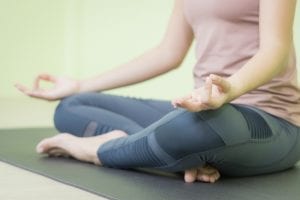
Things to Remember
Do not forget your form while exercising, this is the most important aspect to focus on, especially when it comes to stretching and yoga. Good from means that you are aligning your body as the exercise entails and moving smoothly throughout to avoid injury.
After good form comes reps. The quality of your workout is more important than the quantity. Do as many reps as you can manage with excellent form. The more that you do a workout, the easier it will become with time. After you do a full set, consider adding additional set for a more intense workout.
Workouts should not hurt! If you feel any pain during your workouts, check your form and try again. If the pain persists you may want to check with a doctor, physical therapist or personal trainer before trying the exercise again to ensure your form is correct and that you do not have an underlying injury or condition that could be contributing to the pain.
When trying to conceive, eating certain foods and avoiding others is something that can help to improve your fertility and having the correct snack options before and after your workout is no exception.
Pre-workout Snacks:
Before a workout it is important to focus on a snack that has a good source of carbohydrates that can break down and provide your body with energy. Try to finish eating your pre-workout snack at least 30 minutes before you begin your workout. Your goal is to keep your pre-workout snack under 200 calories.
Here are a few options that you can try:

- Have 1 cup low-fat Greek yogurt topped with ¾ cup berries or other fruit.
- Eat 6 whole grain crackers topped with 1 oz cheese. Try it served with ½ cup berries.
- Spread 1 medium apple with 1 Tbsp natural almond butter.
Post-workout Snacks:
After a workout it is important to refuel your body with carbohydrates, protein, and a little bit of fat. It is best to eat a 200 to 250 calorie snack within 30 minutes of completing your workout. A healthy snack will help to repair the microscopic muscle tears that can occur during exercise.
Here are a few options for a healthy snack:
- Try a wrap with 2 oz grilled chicken breast, 100% whole grain wrap, lettuce, tomato, 1 Tbsp salad dressing, and 1/4 cup shredded cheese.
- Make a yogurt parfait made with 1 cup low-fat Greek yogurt, 1/4 cup granola, 2 Tbsp chopped walnuts, and 1/2 cup berries.
- Have 1 cup of raw chopped veggies such as: celery, carrots, cucumbers; 2 Tbsp hummus, about 100-calories worth of whole-grain crackers
- For a quick on-the-go option, pair one string cheese with a piece of fruit.
Overall
Try not to forget that starting a new fitness routine can be hard. Fitness does not always come easy and that is okay. The key is to keep exercising and listen to your body. Results from exercise can take time to see, so do not overwork yourself and depending on your situation, some women may not reap all of the fertility benefits of a regular fitness plan for up to a year.
It is important to understand that fertility has many factors. While your fitness can play a role, so can your diet, age, and hormones, thus be sure to include your doctor in your fitness goals and habits so they can be aware of everything you are doing to improve your health and fertility.
